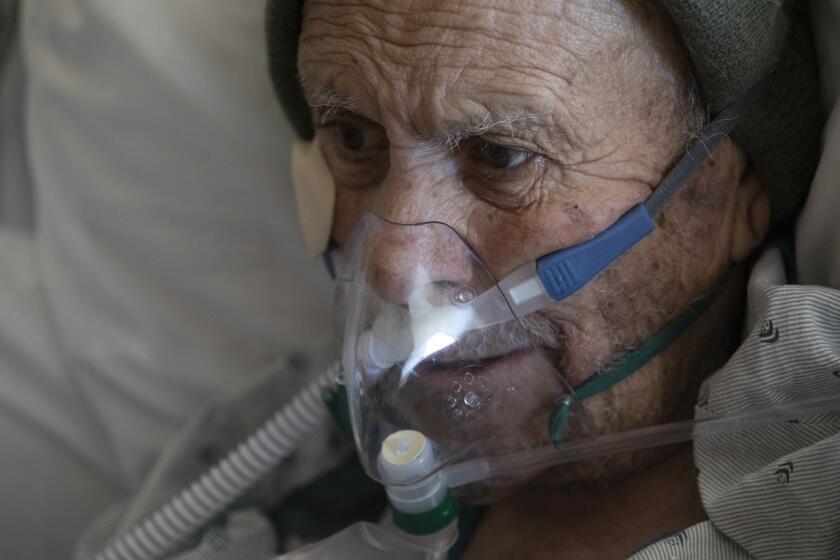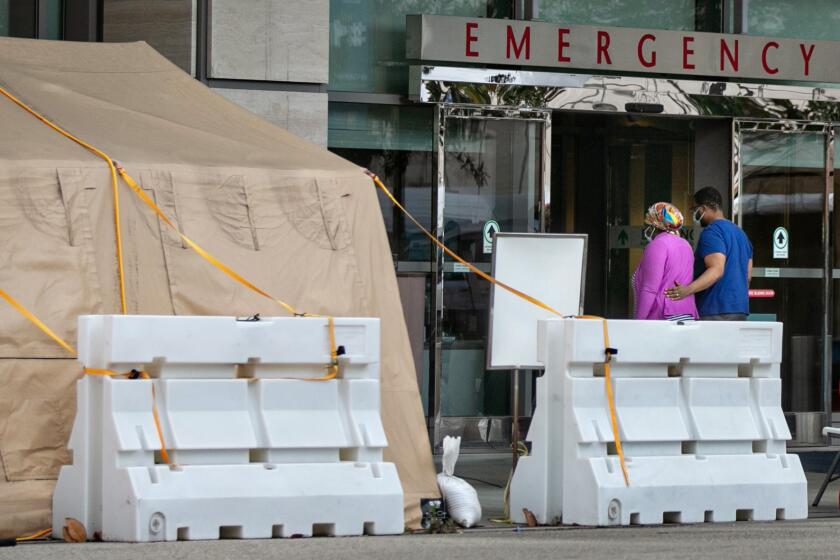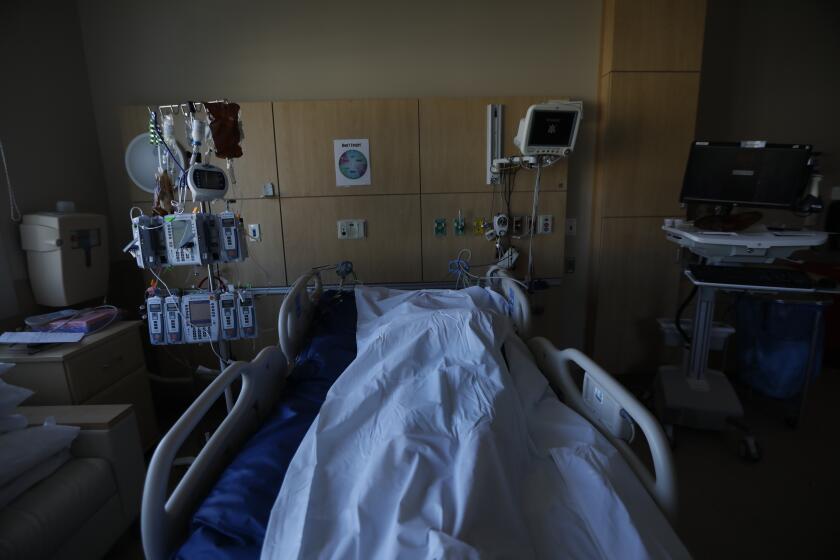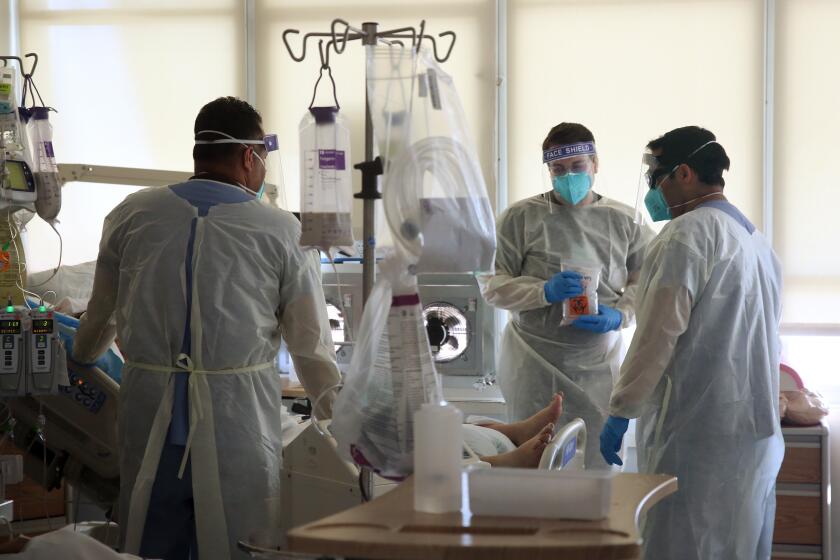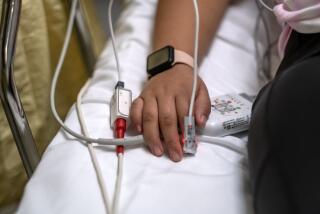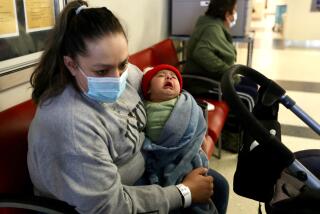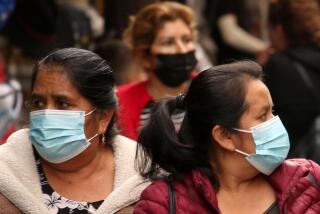Coronavirus surges up the coast: Ventura, San Luis Obispo, Santa Barbara now hit hard
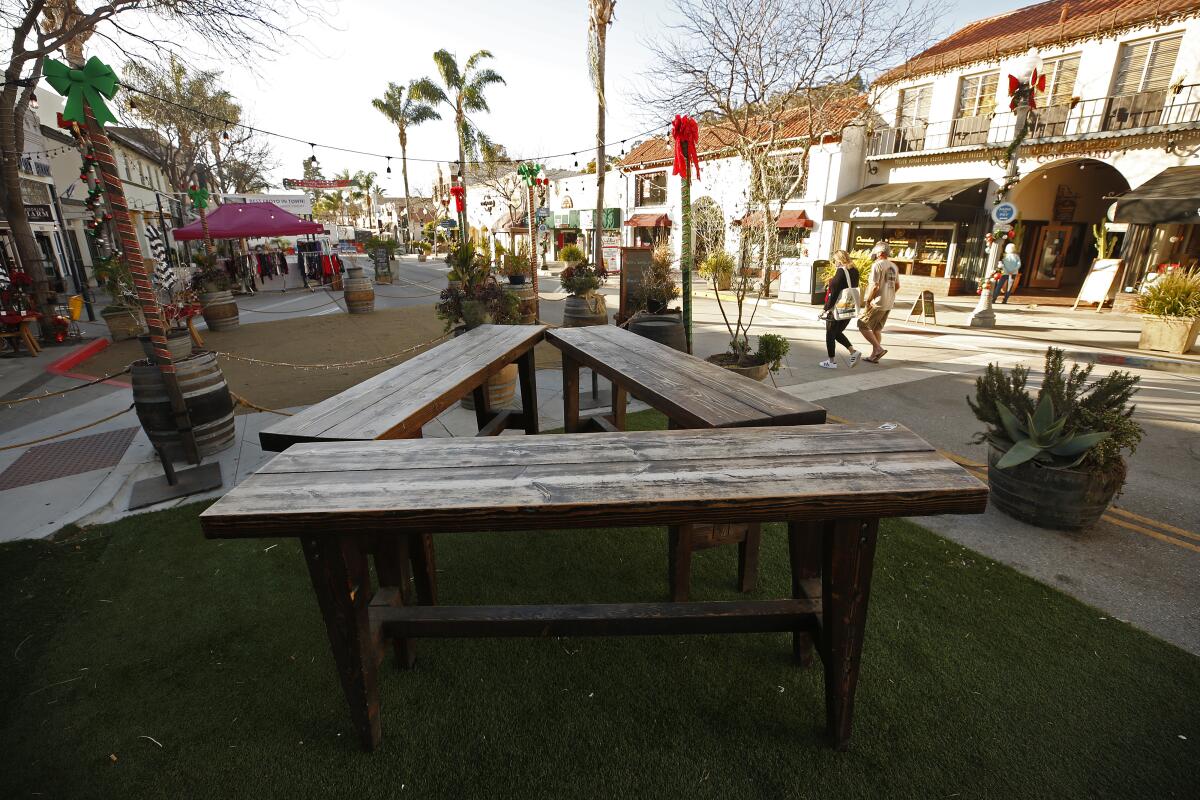
- Share via
Three counties northwest of Los Angeles are experiencing alarming spikes in coronavirus cases, further heightening the level of infections in already hard-hit Southern California and triggering fresh fears about potentially overtaxing local healthcare systems.
Conditions in Ventura, Santa Barbara and San Luis Obispo counties have worsened considerably due to a post-holiday surge of the virus, with the average number of daily new cases more than doubling the rate seen two weeks ago, according to data compiled by The Times.
Infections in Ventura County have risen so rapidly that one doctor publicly wondered whether the area could face its own “New York moment.”
“I’m tired of having to talk to family members to tell them that their family member has passed away from this disease,” Dr. Mark Lepore, intensive care unit physician at Ventura County Medical Center, said last week. “I’m tired of hearing about family members that are coming to the hospital way too late because ... they’re concerned that, when they go, they’re not going to come out alive.”
While Los Angeles, San Bernardino and Riverside counties have been slammed throughout the pandemic, data compiled by The Times show that Ventura County had the third-highest case rate of all California counties over the last week, with 1,033 new infections per 100,000 residents.
By comparison, L.A. County ranked fourth, at 1,006 new cases per 100,000 residents during that same period.
“I’m disappointed that our residents didn’t do better,” Dr. Robert Levin, Ventura County’s public health officer, said Monday. “I think many of them did a wonderful job, and there are many sacrificing people in our county who realize that everything they do to limit their behavior now in terms of human interaction will pay off down the road.”
But there were exceptions — including, notably, actor Kirk Cameron, who starred on the show “Growing Pains.” He organized a demonstration last month in Thousand Oaks where hundreds of maskless people sang Christmas carols to protest California’s stay-at-home orders.
Another possible contributor could be Ventura County’s proximity to Los Angeles, where the coronavirus outbreak has hit harrowing levels. Many people who live in Ventura County work in L.A., and vice versa, he said, and travel between the neighboring counties presents ample opportunity for exposure.
The demand for oxygen has skyrocketed, as critically ill COVID-19 patients often need high rates of oxygen flowing into their lungs to keep them alive.
“I don’t think we have significant data to support that,” he clarified later. “I just think it just stands to reason.”
Significant spikes in new cases are a concern, officials say, not just because they demonstrate that the disease is spreading widely, but because they foreshadow future rises in hospitalizations — and eventually deaths — that will follow.
“We’ll know in the coming week just how serious things are for the hospitals,” Levin said.
Both San Luis Obispo and Santa Barbara counties have reported 886 new cases per 100,000 residents over the last seven days, tied for the 10th-highest rate among California’s 58 counties.
“When we look at COVID data by day, what we see is off-the-chart increases,” Dr. Van Do-Reynoso, Santa Barbara County’s public health director, said during a briefing Friday. “And when I say off the chart, I literally mean off the charts. This week, our numbers increased by so much that we had to adjust the axes and the scales of the charts and maps.”
“The end of this surge only happens when more people and more businesses take control and do the right thing,” Public Health Director Barbara Ferrer said.
But case counts tell only part of the story. The cumulative COVID-19 death toll has doubled in Ventura County since Nov. 1, swelling from 166 to 334. It has risen by about 50% in Santa Barbara County, from 128 to 197, and more than tripled in San Luis Obispo County, from 32 to 111.
Already, COVID-19 hospitalizations have soared across the Central Coast. Since Dec. 1, they’ve quadrupled in Ventura County, going from about 100 to 400; and in Santa Barbara County, rising from about 50 to 200; and quintupled in San Luis Obispo County, from about 10 to 50.
The number of people with COVID-19 in Ventura County’s intensive care units has doubled since Dec. 1, from about 40 to about 80; and nearly quadrupled in Santa Barbara County, from about 15 to nearly 60. There was only one COVID-19 patient in a San Luis Obispo County ICU on Dec. 1; but that number rose to 15 by New Year’s Day, and had settled at eight as of Sunday.
While those raw numbers may seem meager compared with the increases seen in more heavily populated areas, they resonate deeply in a region like the Central Coast, where there are fewer ICU beds.
For instance, San Luis Obispo County has only 38 total staffed ICU beds for its population of about 281,000 — 25 of which were still available on Monday — meaning a sudden surge in hospital demand could quickly leave the county overwhelmed.
Ventura and Santa Barbara counties reported effectively zero available adult ICU beds as of Monday. At one point last week, Ventura County — home to about 848,000 residents — had just five ICU beds available.
The cascading effect of the coronavirus has already had severe consequences for healthcare systems throughout California.
“I think we’re all concerned,” said Dr. Todd Flosi, chief medical officer of Ventura County Medical Center and Santa Paula Hospital. “We continue to be worried that the graph is not leveling out, and that over the next three to four weeks, we’ll see an ongoing increase in patients presenting to all of our ERs and ICUs.”
Five of the highest single-day death tallies for California have been recorded in the last week.
In preparation for a potential surge, Flosi said the two hospitals have worked to secure their resources and bolster their staff numbers to handle an influx of patients. They’ve already set up “disaster tents” in their parking lots and changed their intake processes to triage most patients outside, he said, and are now using back hallways in the ER to limit other patients’ exposure to COVID-19.
Preparations are also underway at Dignity Health’s Central Coast hospitals, including French Hospital Medical Center in San Luis Obispo and Arroyo Grande Community Hospital, Marian Regional Medical Center, and St. John’s Pleasant Valley Hospital and St. John’s Regional Medical Center in Ventura County.
“Our ICU numbers have nearly doubled over the past few weeks,” Dr. Scott Robertson, Dignity Health Central Coast’s chief medical officer, said in an email Monday. “We have enacted our surge plans and are utilizing additional bed space that was prepared for such situations.”
Robertson said the surge is already greater than any of the five Dignity hospitals has seen to date, and noted that they procured additional personal protective equipment, created areas to accommodate more patients and built out separate screening areas for COVID-19 patients in the ER as early as last March. Lately, they have seen enough of an increase in wait times and inpatient volume that they decided to pause elective surgeries, he said — a move already made in L.A. and other southern counties.
But neither Robertson nor Flosi reported the same kind of issues with bed shortages, ambulance backups or faulty oxygen supply systems that have plagued harder-hit counties such as Los Angeles and San Bernardino.
The work of discharge planners has never been more critical, as they try to free up beds in dangerously full hospitals confronting a deluge of COVID-19 patients in Los Angeles County.
Constant communication has also played a role in the region’s preparedness, said Arthur Dominguez, chief nursing officer at San Luis Obispo’s Sierra Vista Regional Medical Center.
Sierra Vista’s patient count is running roughly 5% to 10% higher than normal, he said, but “it literally is hour by hour, day by day.” Like most hospitals, Sierra Vista has been in constant “planning, executing and reevaluating” mode since the start of the pandemic, and has already cross-trained their staff to help out in other departments if needed.
Although Central Coast hospitals haven’t had to take some of the dramatic steps that have become necessary in L.A., they are, by all accounts, ready to do so.
“When you compare it to the news that we’ve been hearing out of Los Angeles the past three to four weeks — we’re not there yet,” Flosi said. “But we are preparing as if we could end up there.”
More to Read
Sign up for Essential California
The most important California stories and recommendations in your inbox every morning.
You may occasionally receive promotional content from the Los Angeles Times.
